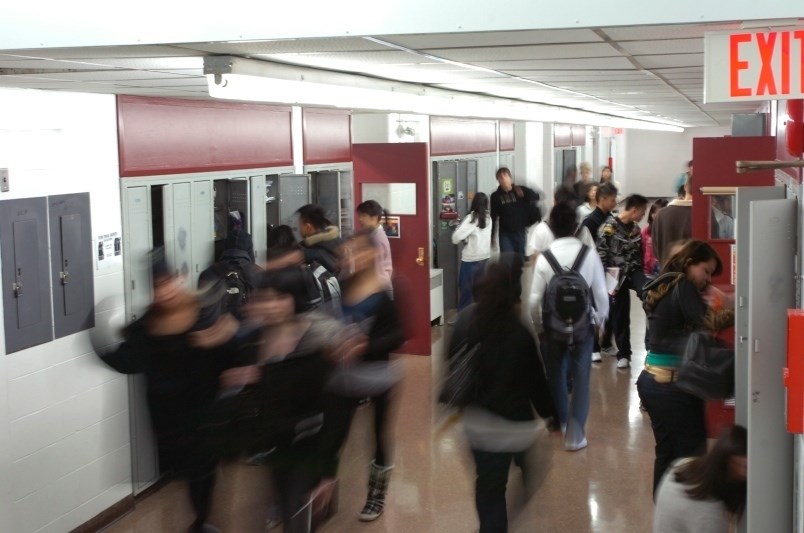The way students with special needs are counted for class composition in ┬ķČ╣┤½├Įė│╗Łcould change next year, after an arbitration ruling earlier this summer.
About 3,000 students in ┬ķČ╣┤½├Įė│╗Łare being reconsidered to determine if they will still count for class composition rules, said Katharine Shipley, president of the ┬ķČ╣┤½├Įė│╗ŁSecondary TeachersŌĆÖ Association. That includes about 1,000 students with autism spectrum disorder and about 2,000 with learning disabilities, Shipley said.
ItŌĆÖs all related to the teachersŌĆÖ 2016 court win, which restored class size and class composition rules stripped from B.C. teachersŌĆÖ contracts in 2002. After the court restored the old provisions, teachers and the government met to try to agree on how special needs definitions had changed, with an eye to updating the language. They couldnŌĆÖt agree, so the matter was referred to arbitration.
Two types of special needs that have changed significantly in the past two decades are autism and learning disabilities. The old definition of autism did not include, as it does today, an entire spectrum of people, including those who have Asperger syndrome or other less severe forms of autism. The number of students in B.C. who were classified as having autism in 2001 was 1,312, but by 2016 there were 8,459, the arbitratorŌĆÖs report says. The increase has many causes, including changes in diagnostic criteria and increasing awareness, but prevalence was increasing before the change in diagnostic criteria, an expert witness said.
With learning disabilities, itŌĆÖs even more complicated. When the language was developed, there was a special needs category that included moderate and severe learning disabilities. Today, that same category includes students with mild learning disabilities.
The arbitrator decided that only students who would have been included under the 1995 definitions should count in terms of class composition.
That means in order to count for class composition, a student with a learning disability must have ŌĆ£a discrepancy of two or more years on grade equivalent scores.ŌĆØ More recent definitions would include a range of students who might need extra time or be slower to process information. Students with autism will also be reconsidered for class composition rules, based on the old definitions.
The ┬ķČ╣┤½├Įė│╗ŁSchool Board is auditing student files to determine which students would meet the 1995 definitions, but says it doesnŌĆÖt know what the review will change.
ŌĆ£We are still╠²undertaking a review of the implications of the arbitration award and have not determined the impacts on class composition at this time,ŌĆØ VSB associate superintendent Carmen Batista said in an emailed response.
Other smaller districts have completed their audits and found that about 30 to 40 per cent of students with autism spectrum disorder and learning disabilities no longer counted for class composition, Shipley said.
Today in ┬ķČ╣┤½├Įė│╗Łschools, if a classroom has more than two students with special needs, the class size is reduced, Shipley said.
ŌĆ£If many of these kids no longer count for remedy or composition, that will have an impact on whether or not our class sizes are reduced,ŌĆØ Shipley said.╠²
ItŌĆÖs important to note the students wonŌĆÖt lose their designation or any services they receive. Any changes would not be made this year, but could take effect next fall.
If the contract had not been stripped in 2002, surely the rules would have evolved along with our expanding knowledge of autism spectrum disorder and learning disabilities. The rules would likely have been slightly different for students with milder disabilities ŌĆö perhaps not a limit of two per class, but maybe a limit of four per class, or some similar compromise.
Jill Barclay, president of ┬ķČ╣┤½├Įė│╗ŁElementary School TeachersŌĆÖ Association, said teachers are very concerned.
ŌĆ£We donŌĆÖt know how many [students] will no longer count,ŌĆØ Barclay said. ŌĆ£The concern is that it negates a lot of our class size and composition language. Those students are still in your class, they still need the support, they still need resource teachers, but class sizes could get bigger.ŌĆØ╠²
In the best of all possible worlds, teachers and their employer would have sat down and worked out a viable compromise.
But given we donŌĆÖt live in a utopia ŌĆö even this teacher-friendly NDP government has not reached a contract deal with teachers and has proposed moving to a prevalence funding model that would render moot the class composition language teachers fought in court for more than a decade for ŌĆö we may soon land in a world where some kids with special needs simply ŌĆ£donŌĆÖt countŌĆØ for class composition, and thatŌĆÖs definitely not a step forward.
╠²
╠²



